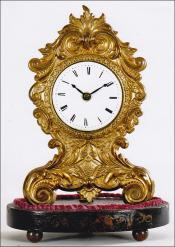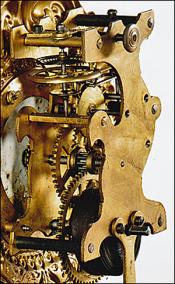Chauncey Jerome, The Paris model. A mantel clock under a glass dome. 212097.
This beautiful clock was made by Chauncey Jerome of New Haven, Connecticut, in the early 1850s. These were originally constructed in several formats and various combinations of materials. Some models had papier mache facades; others, like this example, featured a pressed brass front. All of which featured a Samuel Norton Botsford balance wheel escapement.
Samuel Botsford was a Bristol, Connecticut native born in 1815. He was considered by many to be a brilliant inventor. He invented the double-wheeled escapement in this clock. He was also very interested in setting off the gunpowder with an electrical charge.
This Paris model is a very attractive clock. The wooden base is set up on three ball feet. The outside front facade of the base retains its original stencil decoration, which is in surprisingly lovely original condition. The wooden base provides a platform for the protective glass dome and is a mounting point for the clock. The dome is original to this clock. Unfortunately, it is challenging to photograph in place due to the reflections that appear in the curves. The framing for the dial is repousse brass. The brass is pressed thin, and the details are excellent. This facade retains its original gilding. It is designed and constructed in this manner to imitate the fancy French clocks of the same period. To give the case even more French flair, you will find the word “Paris” embossed in the pressed brass below the dial. The porcelain dial is in nearly perfect condition. The time ring features finely formatted Roman hour numerals. The movement is spring-driven and may run for eight days on a full wind. It incorporates in its design the Botsford improved patent, having brass plates, a large horizontal balance wheel, and an odd-looking escapement, which is often referred to as the American Grasshopper escapement. It makes a very distinctive sound when running, and it is visually interesting to watch its operation.
This clock measures approximately 11.5 inches tall, 8 inches wide, and 5 inches deep.
It was made circa 1850.
Inventory number 212112.
Chauncey Jerome was born in 1793 in Canaan, Connecticut, the son of a blacksmith and a nail-maker. He has a storied history in the Connecticut clock industry, becoming one of our nation's giant employers and producers during his lifetime. His autobiography has been reprinted and is available at the American Clock and Watch Museum in Bristol, CT. It is a worthy read.
Chauncey began his clockmaking career as a joiner. First, making wooden dials for tall clocks, and then in 1816, he went to work for Eli Terry. Jerome made the cases for Terry's Pillar & Scroll shelf clocks. Soon, he decided to work for himself, making cases and trading them with Terry for his movements. By 1822, Jerome moved his business to Bristol. He was an innovator in clock case construction and design. In 1842, he again moved his shop, this time to New Haven.
In 1850, Jerome formed the Jerome Manufacturing Company. In 1853, he formed the New Haven Clock Co.
Throughout his lifetime, he weathered numerous business disasters and windfalls. He was a well-respected citizen and served in the state legislature and as mayor of New Haven. He died penniless in 1868.




